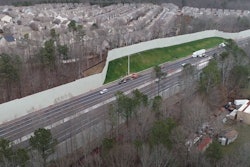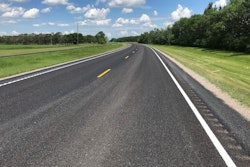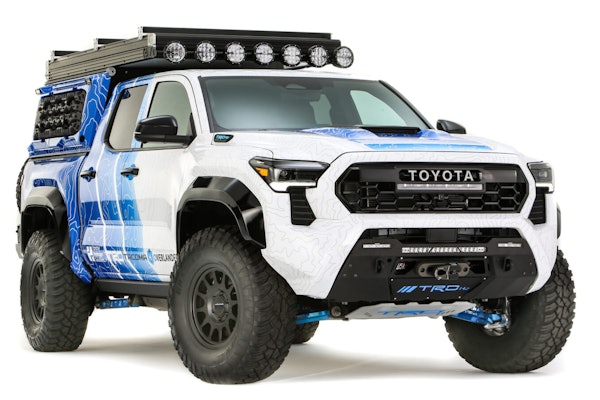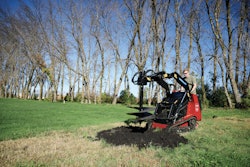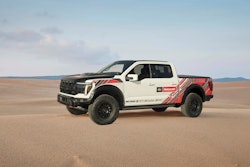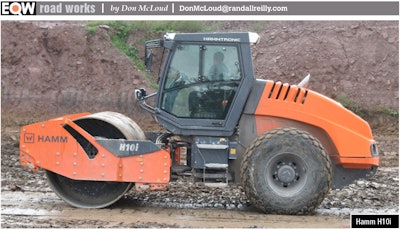
Simple for the operator, that is.
“A good soil compactor is one that’s simple to operate and reasonably comfortable for the operator, and it just doesn’t break,” says Mark Eckert, Volvo Construction Equipment global product manager.
Such simplicity is important, according to manufacturers, because the soil roller is often an introductory machine, and on some jobsites, there may not be a dedicated operator so various workers run it as needed.
Though simple is the watchword, today’s compactors often come standard with or have a variety of optional technology that might seem complicated but can make operating a soil compactor even easier. The advanced technology is also a nod to younger operators who like technology and the quicker learning curve it can provide. And contractors facing labor shortages and a lack of experienced operators can yield higher production numbers and increased efficiency.
What tech is right for you?
Of course, that new technology can carry a hefty price, especially when it comes to intelligent compaction.
But OEMs have been adding several new advancements that stop short of full IC yet provide some powerful tools for operators and require pushing only a button or two. Such technology can automatically adjust drum frequency to the material being compacted, count roller passes and alert the operator when targeted compaction has been achieved. It comes with a lot smaller price tag, and in some cases, is standard equipment.
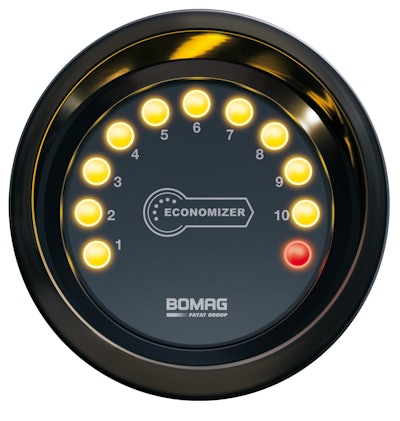 BOMAG’s Economizer display
BOMAG’s Economizer displayFor example, BOMAG offers steps toward intelligent compaction, starting with its new Economizer at a much lower cost than full IC. Economizer provides operators with a simple data gauge with 10 lights. Fewer lights shining indicates lower stiffness levels, and more lights mean higher stiffness.
“It’s more like the traffic-light approach, giving a simple indicator to the operator to follow,” says Bert Erdmann, BOMAG heavy compaction product manager. “If you have four, five, six lights coming up and they stay steady, then you know you’re pretty much done operating there on vibrating, so you can move on to the next spot without wasting passes.”
Dynapac has rolled out its Seismic product as standard equipment for its models CA1500 and above for the North American market. Seismic automatically adjusts vibration frequency to the soil conditions. It uses sensors in the drum to gauge the type of material being compacted.
For example, sandy soil needs less vibration frequency than clay. The sensors then send signals to the onboard computer, which adjusts the frequency to the sandy soil.
“So by doing that, you’re getting faster compaction, fewer numbers of passes, and using less fuel,” says Vijay Palanisamy, Dynapac director of product marketing and communications. The compaction value is shown on the screen in real time, which the operator can reference to the target value. “Once you reach it,” he says, “you can move on to the next area to compact.”
Seismic also includes an Active Bouncing Control System that automatically shuts off the drum vibration when it reaches maximum compaction. This prevents the drum from double-jumping, which can damage the machine.
The next step up from these technologies centers on full intelligent compaction, which consists of an onboard measuring system of the material bring compacted, GPS that pinpoints the roller on the screen map display and an integrated mapping and reporting system. IC systems continuously monitor compaction quality and allow for addressing any weak areas.
Volvo’s Eckert says about 70 percent of its customers that switch to its IC system, called Compact Assist, do so because of a project owner requiring it. The remaining 30 percent switch to it because of the technology’s benefits. Advantages, he says, include improved consistency, proof of proper compaction and number of passes, and matching compaction on a job from bottom to top if using IC on other machines in the paving process.
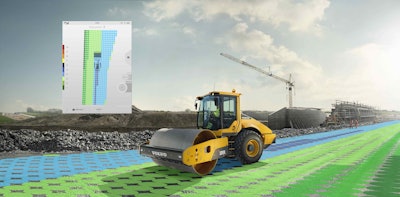 Volvo Compact Assist pass mapping
Volvo Compact Assist pass mappingAlong with improved quality and efficiency, Tim Kowalski, Hamm applications support manager, says IC can be a great training tool for new operators, and it also helps when working at night. The HCQ (Hamm Compaction Quality) system shows the operator a split screen, one to color-code the pass count and the other for stiffness. “So we can see what we’re doing after each pass, whether the stiffness is increasing or decreasing,” Kowalski says.
Case Construction Equipment has developed the ACE Force intelligent compaction system. Jeremy Dulak, Case compaction product and marketing manager, says the system is “designed to improve compaction quality, requiring fewer passes to reach target specs and resulting in savings in time, fuel costs and machine maintenance.” It measures stiffness in real time and prevents over- and under-compaction, he says.
Edging closer to automated compaction, Caterpillar introduced Command for Compaction for its B-Series soil rollers this year. The option enables the operator to set a few parameters on a touchscreen and hit “auto.” The system automatically controls the compactor’s forward and reverse movements and vibration. It uses common base stations and does not need design input or back-office assistance, Cat says.
Also heading down the autonomy road is Dynapac, which has partnered with Trimble for an auto-steer and auto-speed system for its soil compactors. Palanisamy says the system is still being developed and would enable the operator to choose manual or the Autonomy mode. The original goal was to release it in 12 to 24 months, but the pandemic might lengthen that time frame, he says.
How to choose the right soil compactor?
Regardless of the soil compactor’s advanced technology, manufacturers stress the need to focus on the jobs and types of soil where the roller will be used most.
For roadbuilding, compactors with an 84-inch drum are most popular.
But in some cases, particularly if it’s just an 8-inch lift, a city street or alley, a 66-inch-wide drum might be adequate and cost less to rent or buy. Eckert, of Volvo, notes that many road jobs today focus on adding a lane or on reconstruction, rather than building a new highway, so a 7-ton roller versus a 10-ton roller might suffice.
Smaller compactors in the 47- to 55-inch range are usually preferred for trench work and paths.
The type of soil you’ll be working on is also a major factor. Soil compactors come in two main versions, either single smooth-drum vibratory or single padfoot-drum vibratory.
Contractors working in sandy-type soil such as found in the Southeast favor smooth drum, while those working in more cohesive soil, such as clay, typically use a padfoot drum. Contractors might also work in both types of soil. In that case, they can either buy or rent separate dedicated machines, or they can opt for a shell kit to convert the existing drum to either smooth or padfoot. Most major manufacturers sell them for their compactors.
Another thing to consider is the climate you’ll be operating in and whether you’ll want an enclosed cab or ROPS. “We’re seeing more requests for cabs, and we’re seeing in certain areas of the U.S. where they’re almost all going to cabs,” says Brad Belvin, Sakai sales and marketing manager. “…If you can keep the operator comfortable, then they’re going to keep coming back to work.”
Contractors should also consider the machine’s ability to maintain traction and to operate on inclines. Roadwork tends to be mostly flat; however, highway ramps and other conditions could require a compactor with a higher degree of gradeability and high traction. If buying, also ask about warranties, length of life for wear parts and total cost of ownership. Above all, experts say, talk with your sales or rental dealer to make sure you get the right compactor.
“It’s important for contractors to understand not only the size, application and type of jobs they are currently doing, but the type of jobs they want to grow into in the future,” says Case’s Dulak.
What’s on the market?
We asked major manufacturers of soil compactors to recommend their top offerings for roadbuilding contractors.
All of the compactors come in single-drum and padfoot versions. Here’s a look at what’s on the market today:
SAKAI
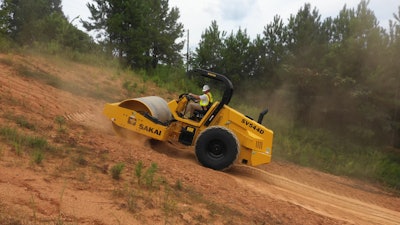 Sakai SV544D
Sakai SV544D“I think one of our biggest features is we really design machines simply, and we also design the engineering criteria as simple,” says Belvin. “There’s less to break, so the machine is always up.”
He suggests Sakai’s 67-inch-wide SV414 or 84-inch SV544.
“There’s no electric-over-hydraulic steering on our machine,” he adds. “It is a direct-drive system where when you push the lever forward, it strokes the pump, and then when you push it back, it strokes the pump the other way. it’s incredibly simple. And we have a safety brake as well, which will bring that back into neutral.”
Other features include optional ROPS cab with air conditioning, manual traction control for compaction in both forward and reverse on slopes and challenging terrain, and a drum vibration-isolation system and floating deck to prevent vibrations from reaching the operator.
Both the 414 and 544 can be equipped with intelligent compaction systems from major aftermarket providers Trimble, Topcon and Leica Geosystems.
BOMAG
 BOMAG BW 213-5
BOMAG BW 213-5BOMAG offers a variety of technology for operators to make compaction more consistent and easier to achieve.
The next step up after Economizer, which uses lights to show when proper compaction is achieved, is the company’s Terrameter. Erdmann says this technology delivers a stiffness value readout and a bar graph. The system helps prevent unnecessary passes and identifies weak spots.
Erdmann says another popular feature is the BOMAP app, which can be downloaded free on an Android tablet. With the tablet installed on the roller, the operator can get a pass count and mapping. It can be tied in with Economizer or Terrameter. It will show where the weak spots are, so they can be corrected.
He recommends the 11-ton BW211 or 13-ton BW213 in the 84-inch drum range, and the BW145 or BW177 for inner-city jobs.
Compactors are available with open ROPS/FOPS or with enclosed cabs with heat or with heating and air conditioning.
HAMM
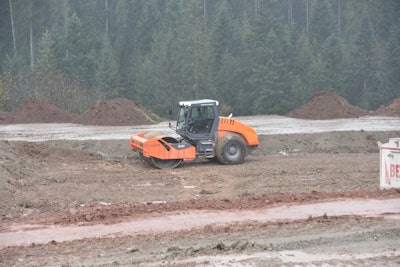 Hamm H10i
Hamm H10i“The biggest thing that we look at on our soil rollers is our three-point articulation joint,” Kowalski says. “It helps balance the machine so that you get more even compaction across the width of the drum when you’re making turns. And it also gives you much better traction ability, whether it be on level ground or even on side hills.”
He also points to Hammtronic, which automatically delivers more power and traction where it’s needed when climbing and saves fuel in less demanding applications. Hamm’s EasyDrive system keeps all of the compactors’ controls uniform across the company’s models. That way an operator doesn’t have to relearn a new operating system after switching machines on a job.
Kowalski says that in the 84-inch range the 10-ton H10i is the company’s most popular rental for roadwork, and the 12-ton H12i is the one he would recommend a contractor purchase because of its versatility. In the 66-inch range, Hamm offers the 7-ton H7i.
DYNAPAC
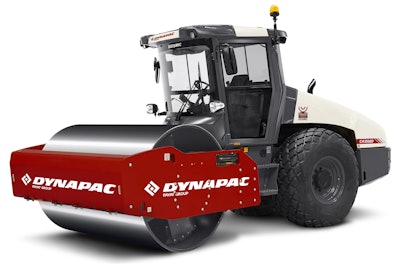 Dynapac CA3500D Seismic soil roller
Dynapac CA3500D Seismic soil rollerAlong with the standard Seismic technology that adjusts vibration to the material, Palanisamy cites Dynapac’s automatic spin control that detects which side of the drum or which tire is spinning and automatically directs power to adjust.
Dynapac’s standard cabs feature seats that can swivel 180 degrees and the controls move with them. “You can sit in it sideways,” he says. “You can sit any angle, and you can operate the machine so you don’t have to look front and back.”
He recommends the 10.5-metric-ton CA2500 and 12-ton CA3500 in the 84-inch range and the CA1500 in the 66-inch range.
The CA3500 and CA2500 are also offered in High Climb (HC) versions, which provides the ability to climb the same grade in reverse as in forward, at up to 55 percent gradeability. That comes in handy for compacting trenches and pipelines where you can’t turn the compactor around, the company says.
VOLVO
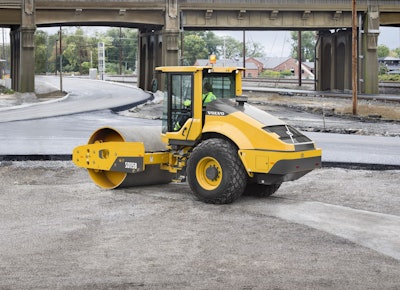 Volvo SD115B
Volvo SD115BVolvo Construction Equipment uses a similar cab on its soil compactors as on its wheel loaders with the window extended down for better visibility. The cab is pressurized and quiet, Eckert says.
An optional traction system makes the roller able to handle extreme conditions, and an eco-mode reduces fuel consumption. For safety, Volvo’s compactors will automatically cut off in 5 seconds if the operator leaves the seat without putting it in park and engaging the brake.
The company provides a one-year free subscription to its ActiveCare Direct telematics monitoring system. “We do the monitoring for you,” Eckert says. Those monitoring the data of CareTracks telematics at Volvo’s center in Shippensburg, Pennsylvania, communicate with dealers to provide quick response if a machine requires attention. Contractors also receive a monthly fleet utilization report.
For the 84-inch range, Eckert recommends the SD115B, and he suggests the 66-inch SD75B for jobs with an 8-inch lift, when a lighter machine will suffice.
CASE
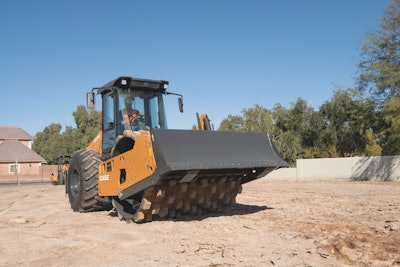 Case SV211E
Case SV211ECase unveiled its E Series soil rollers this year with a new frame design, new cab or open ROPS configuration, and new Tier 4 Final engines. Other features include an optional front dozer blade and improved cooling package.
Case says the rollers have best-in-class centrifugal forces. An automatic traction control option enables the compactors to climb grades as steep as 67 percent. Seats are adjustable and swivel up to 80 degrees for visibility of the drum. The roller’s back is sloped for better visibility to the rear, and the drum has a smaller diameter with a thicker shell for better front visibility and maneuverability.
Dulak recommends Case’s SV211E, which he says is the company’s most popular soil compactor because of its size. It weighs 11.6 to 13.4 metric tons, depending on the configuration. It has an 84-inch-wide drum and can handle small to large jobs, he says. Along with the improvements already mentioned, Case made the SV211E about 7 inches shorter than its predecessor and gave it a 3 percent increase in turning radius for better maneuverability.
CAT
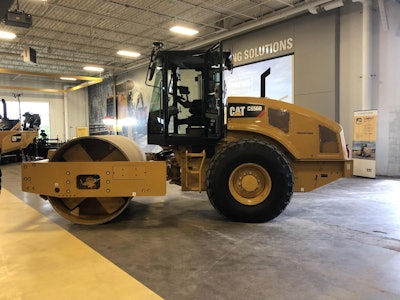 Cat CS56B
Cat CS56BThe drums on Caterpillar’s soil rollers feature a “pod-style vibratory system” that the company says is “virtually maintenance free.”
Cat also gave its compactors “Auto-Vibe,” which when engaged stops vibration when the roller drops below a pre-set speed. Vibration will automatically resume when the roller reaches a predetermined speed. Cat says this leads to consistent compaction quality.
Caterpillar manufactures six single smooth-drum and four padfoot soil compactors with drum widths of 84 inches and operating weights ranging from 10.5 to 18 metric tons. Its CS44B and CP44B have drum widths of 66 inches and weigh 7 metric tons.
The company offers two compaction measurement systems. Compaction Meter Value is for its smooth-drum models and gives the operator a real-time view 3 to 4 feet beneath the surface to reveal objects or poor compaction. Its Machine Drive Power system is for both smooth and padfoot rollers and can be used in all soil types. It indicates stiffness by measuring rolling resistance.





